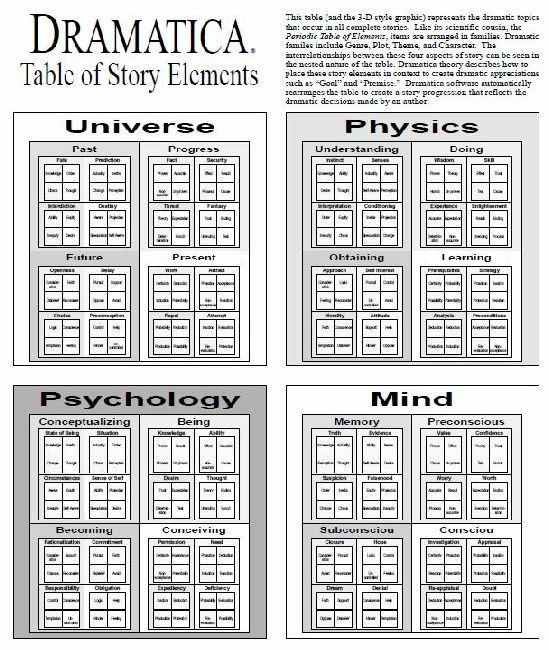What is Dramatica? Dramatica is a theory of how story structure works that was developed 25 years ago and is implemented in a line of software products to help writers structure their stories.
What makes Dramatica different from other approaches to story structure? There is a central concept in Dramatica that is unique and sets it apart from every other story development method. That concept is called the Story Mind.
What is the Story Mind? According to the theory, we all have certain basic mental processes such as Reason, Emotion, Skepticism and Conscience. When we gather together in groups toward a common purpose, we quickly self-organize so that each individual comes to focus or specialize in just one of those processes. For example, in an organization one individual will emerge as the voice of Reason for the group and another as the resident Skeptic.
The reason for this is that by specializing, each individual can give all his or her attention to a single approach to solving the group’s problems or to exploring an issue of common concern. In this manner, the group as a whole is able to get far more depth of consideration in each area from the specialists than if everyone was a general practitioner trying to do all the jobs at once, like we do when we are working on personal problems or issues in our individual lives.
Generations of storytellers sought to understand and document what they saw in the real world so that they might provide the value of experience on the best way to deal with both personal and group problems to their readers or audiences. And so, by trial and error, they arrived at the conventions of story structure: dramatic elements and sequences of events and growth that mirrored what they had observed.
Because storytelling is done in a linear sequence – a timeline – until Dramatica is was thought that structure was linear too. This is how structure was viewed from the time of Aristotle in his book about stories called Poetics. It is also the approach documented in the famous Hero’s Journey. And so the generally accepted approach to developing a story involved figuring out what ought to happen next.
But the developers of Dramatica realized that story structure operates more like a Rubik’s Cube where every story point is related to every other. At one level, characters are just like individuals – trying to solve their personal problems and move on. But at another level, characters are like the specialists in a group mind: single-faceted archetypes working toward (or against) the common purpose that is the story goal.
In short, we tell stories temporally, but we create and understand them spatially. Readers or audience members gather information about a story’s underlying message over time, but once the story is over, they understand it as a whole – a story world – a narrative – complete and seen all at once.
How a story is unfolded over time changes the audience experience, but does not change how the dramatics are arranged within the story itself. And so, an author’s job is two-fold. First, he or she must create a structure for their story or an argument to support their message that makes sense as a network of interconnected dramatics. Second, that story must be doled out over time through exposition in the manner that will create the most powerful audience experience.
Armed with this understanding, the developers of Dramatica went back to stories to see if they could find that split-level structure and, in fact, discovered that is exactly what was happening at a structural level in every successful story they examined, be it novel, screenplay, stage play, or television episode.
They then spent the next three years mapping all the dramatic elements in the Story Mind, determining how they affected one another, and finding the patterns that explained how characters grew and how plot advanced.
The result of this work is the familiar Dramatica Table of Story Elements seen below in its flat form:

It looks pretty daunting and complicated on first glance, but it is really nothing more that a list of all the story elements in a complete narrative structure, large and small, organized in families of similar dramatics.
Now you don’t have to learn all of these. The most important ones are the names of the biggest families like Universe, Physics, Mind and Psychology. Sounds all scientific and not very writerly, and even a bit scary at first, doesn’t it?!
But, when you learn about how to use even these first four items, you’ll find that your ability to craft your story’s structure to be just the way you want it jumps up several notches from where it was.
For example, Universe just means some external situation you can’t seem to do anything about – the material world. So, if you are stuck in an upside down boat in the middle of the ocean, that’s a Universe story. If you have a physical problem like the Elephant man, that’s also a Universe story because he, as the main character, is stuck with a material situation he can’t do anything about.
But, if you are a main character like Scrooge in A Christmas Carol, then the problem isn’t your situation but your attitude. And we find Scrooge fits into the Mind set of dramatic elements, rather than the Universe ones.
All the dramatic items in each of these four major families help make the supporting arguments that prove an author’s message about the best way to deal with or overcome a bad situation or to learn that one has a bad attitude and then to find a way to change it.
That’s what stories are all about, after all, is to share insight into how to solve the kinds of problems we face in real life every day, even if the message is masked as a science fiction or an historical period piece.

